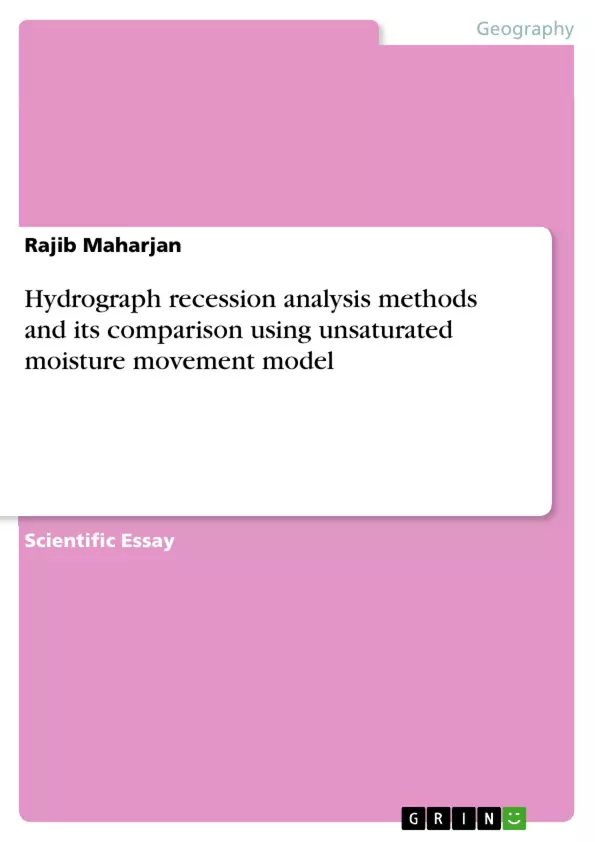Groundwater plays an important role in feeding springs and streams, supporting wetlands and land surface stability. In Finland, most water is held in the soil than the surface systems. Hence, Finland’s water resources depend on groundwater and biogeochemical processes. The study of groundwater in peatland is important for maintaining ecological balance and conservation of water resources. The groundwater level is one of the key indicators of aquifer conditions and groundwater basins. It helps to interpret hydrogeology, groundwater flow, groundwater sustainability and land usability. The study tries to analyze ground water recharge on peatland catchments using hydrograph recession analysis. The equation for the hydrograph recession curve can be utilized to predict groundwater recharge during each recession period. The steps involved during recession curve analysis includes selection of analytical expression, derivation of recession characteristic and optimization of the parameters. While computing groundwater recharge with recession curve, the high variability of each recession segments creates major problem. Each segment shows the outflow process which creates short-term or seasonal influence. The variation in rate of recession which causes problems for derivation of recession characteristics. The computer software such as hydro-office, VBA macro excel and Matlab are used for recession analysis. The results obtained do not consider climatic influences. The results were then confirmed by using water balance model and statistical tests. The e-water toolkit is used for water balance model and statistical tests are performed using R-software. The rainfall-runoff data are used as input to the software used in each method. From the analysis, required output recession parameters are obtained for further calculation. These estimated recession parameters can be used to predict low flows (groundwater contribution to runoff) to understand catchment groundwater resources and as inputs for the rainfall-runoff model analysis. Hence, the objective of this study is to analyze groundwater recharge by studying the recession limb of the runoff hydrograph. The study work compares various recession analysis methods. It also tries to identify the better method by comparing groundwater recharge from different methods with groundwater recharge from unsaturated water balance model.
Inhaltsverzeichnis (Table of Contents)
- 1 Introduction
- 2 Site Description
- 3 Methods
- 3.1 Hygrograph recession analysis
- 3.1.1 Individual Recession Analysis
- 3.1.2 Master Recession Analysis
- 3.1.3 Wavelet transformation
- 3.1.4 Recession constant and recharge from baseflow separation
- 3.1.5 Recession constant and storage from specific yield
- 3.2 Unsaturated moisture balance components
- 3.1 Hygrograph recession analysis
- 4 Calculations
- 4.1 Hydrograph recession and Specific approach
- 4.2 Recharge volume from unsaturated water balance
- 5 Results
- 6 CONCLUSION
- Acknowledgment
- References
Zielsetzung und Themenschwerpunkte (Objectives and Key Themes)
The study aims to analyze groundwater recharge in peatland catchments using hydrograph recession analysis. The objectives are to:- Compare various recession analysis methods.
- Identify the best method for calculating groundwater recharge by comparing results with an unsaturated water balance model.
- Analyze the influence of climatic factors on runoff hydrographs.
- Investigate the relationship between recession constants obtained from different methods and theoretical values.
- Utilize statistical tests to confirm the significance of the results.
Zusammenfassung der Kapitel (Chapter Summaries)
- Chapter 1: Introduction: This chapter provides an overview of the importance of groundwater in peatland ecosystems, particularly in Finland. It highlights the significance of hydrological studies for understanding peatland functions and their impact on ecological and socio-economic aspects. The chapter outlines the study's objective of calculating yearly groundwater recharge using hydrograph recession analysis and examining the influence of climatic factors.
- Chapter 2: Site Description: This chapter details the characteristics of the two peatland catchments, Marjasuo and Röyvänsuo, which were studied. It describes their geographical location, land area, and vegetation composition. Both catchments are located in northern Finland and possess similar terrestrial and soil formations. The chapter also includes a map showing the location of the catchments.
- Chapter 3: Methods: This chapter outlines the methodology employed in the study. It discusses the recession analysis method, including individual recession analysis, master recession analysis, wavelet transformation, and baseflow separation. The chapter also explains the use of an unsaturated water balance model for calculating groundwater recharge. Finally, it mentions the statistical tests conducted to validate the results.
- Chapter 4: Calculations: This chapter elaborates on the specific calculations involved in the hydrograph recession analysis and the unsaturated water balance model. It describes how recession parameters are derived and how groundwater recharge is estimated using different methods.
Schlüsselwörter (Keywords)
The study focuses on the analysis of runoff hydrographs and their application in determining groundwater recharge in peatland catchments. Key terms include: runoff hydrograph, recession parameters, runoff, groundwater recharge, unsaturated water balance, and statistical tests. The study employs various methods, including hydrograph recession analysis, baseflow separation, and an unsaturated water balance model, to evaluate groundwater recharge in the context of climatic influences and hydrological processes.- Quote paper
- Rajib Maharjan (Author), 2014, Hydrograph recession analysis methods and its comparison using unsaturated moisture movement model, Munich, GRIN Verlag, https://www.grin.com/document/280795



